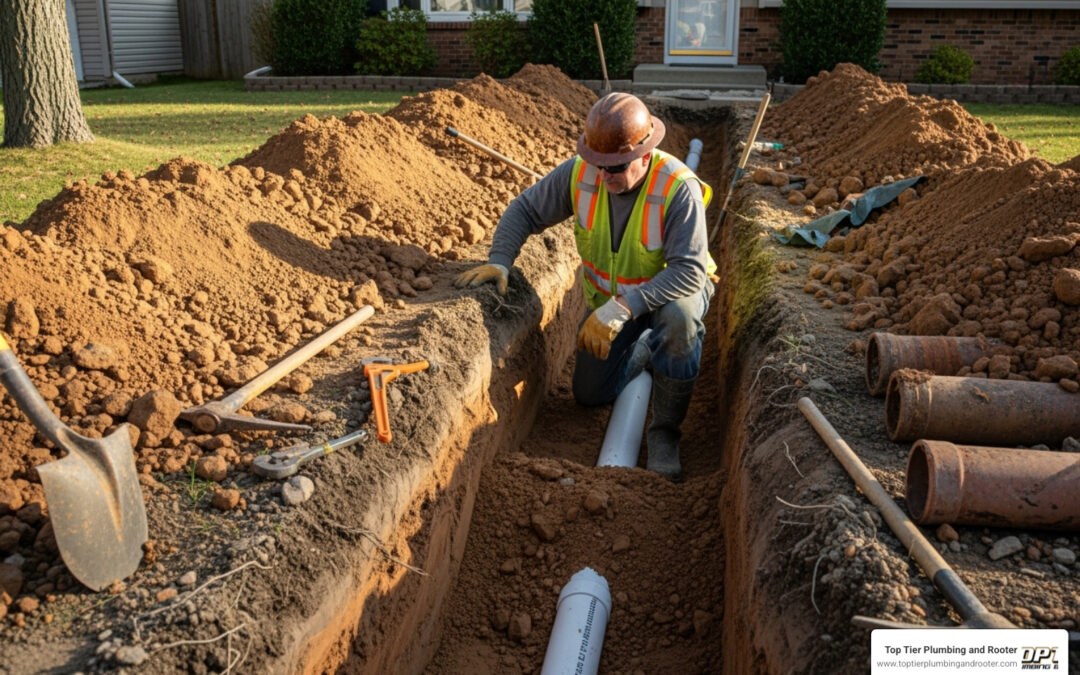Why Residential Sewer Replacement Is Critical for Homeowners
Residential sewer replacement becomes necessary when your home’s main sewer line – the pipe that carries all wastewater from your house to the city’s main sewer system – fails beyond repair. Here’s what every homeowner needs to know:
Key Replacement Options:
- Traditional excavation – Complete digging and pipe removal
- Trenchless pipe bursting – Breaking old pipe while installing new one
- Pipe lining (CIPP) – Creating new pipe inside existing one
- Spot repairs – Fixing isolated damage sections
When replacement is needed:
- Collapsed or severely damaged pipes
- Recurring backups and clogs
- Old pipe materials (clay, cast iron from 1950s-60s)
- Extensive root intrusion
- Multiple joint failures
Your sewer line is your responsibility as a homeowner, typically from your house to the street connection. Unlike visible plumbing fixtures, this underground system works silently until something goes wrong.
Most homes built before the 1980s used materials like clay tile or cast iron that are prone to cracking, root intrusion, and corrosion. Modern replacement options can extend your system’s life by 50-100 years while reducing future maintenance headaches.
The choice between repair and replacement depends on the extent of damage, pipe age, and long-term reliability needs. A professional camera inspection reveals the true condition of your line and helps determine the most effective solution.
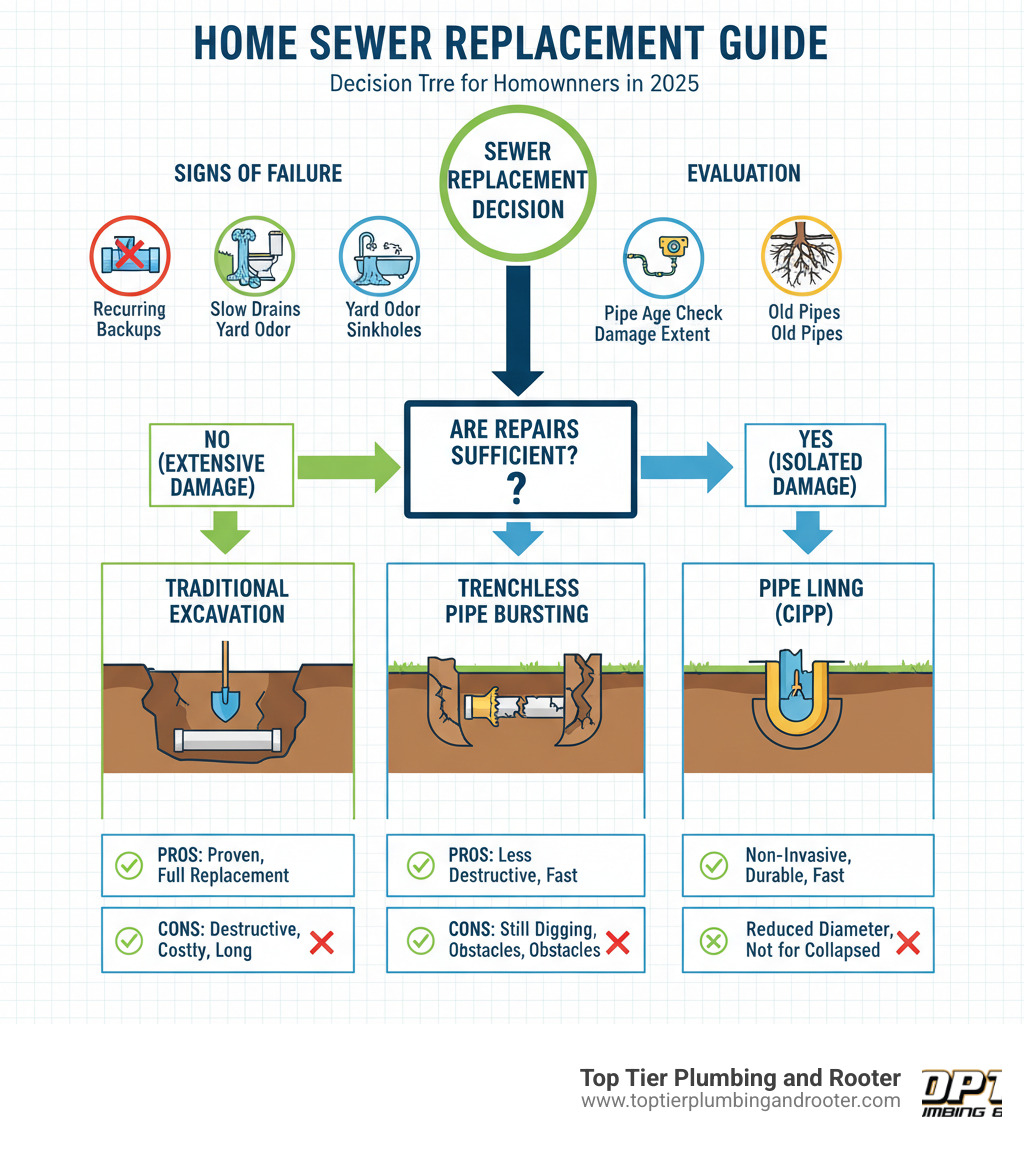
When it comes to your home’s plumbing, few things are as unsettling as a failing sewer line. It’s not just an inconvenience; it can pose serious health risks and lead to significant property damage. As experts in residential plumbing and rooter services in Riverside and San Bernardino counties, we understand the stress and confusion that comes with these issues. Our goal with this guide is to explain residential sewer replacement, equipping you with the knowledge to identify problems, understand your options, and make informed decisions for a healthier home.
Telltale Signs of a Failing Sewer Line
Your home’s sewer line is like a silent workhorse – it faithfully carries wastewater away from your home without fanfare or recognition. But when this underground hero starts to fail, it doesn’t suffer in silence. Instead, it sends out clear distress signals that something’s wrong beneath the surface.
The trick is knowing what to look for. Some signs practically shout for attention, while others whisper their warnings through subtle changes in your yard or home. Catching these early warning signs can mean the difference between a manageable repair and a full residential sewer replacement emergency.
Obvious Indoor Symptoms
When your sewer line is in trouble, your indoor plumbing usually sounds the alarm first. These symptoms are hard to ignore and often signal that it’s time to call in the professionals.
Slow drains are often the first hint that trouble is brewing. When your kitchen sink takes forever to empty or your shower leaves you standing in ankle-deep water, it’s easy to blame a simple clog. But when multiple fixtures throughout your home start draining sluggishly, that’s your sewer line crying for help.
Multiple fixtures clogging at the same time is an even bigger red flag. If your toilet backs up right after you run the washing machine, or your bathtub gurgles when you flush the toilet, you’re dealing with more than coincidence. This coordinated chaos points to a blockage or damage in your main sewer line.
Those gurgling toilets aren’t trying to communicate with you – they’re struggling to breathe. When air gets trapped in your drain lines due to blockages, your toilet makes those unsettling sounds after you use other fixtures. It’s like your plumbing system is gasping for air.
Sewage backups represent the ultimate plumbing nightmare. When wastewater has nowhere else to go, it comes back up through your drains, toilets, or tubs. This isn’t just disgusting – it’s a health emergency that demands immediate professional attention.
Foul odors from drains can make your home feel less like a sanctuary and more like a swamp. These persistent smells often indicate breaks in your sewer line that allow dangerous gases to escape. Sewer gas can be harmful to your health because it contains nasty compounds like hydrogen sulfide, ammonia, and methane.
If you’re experiencing any of these symptoms, our guide on Why Do I Have a Clogged Sewer Line? can help you understand what might be causing the problem.
Subtle Outdoor Clues
Sometimes your yard becomes a detective, revealing clues about underground sewer problems before your indoor plumbing catches on. These outdoor signs require a keener eye, but they’re just as important to recognize.
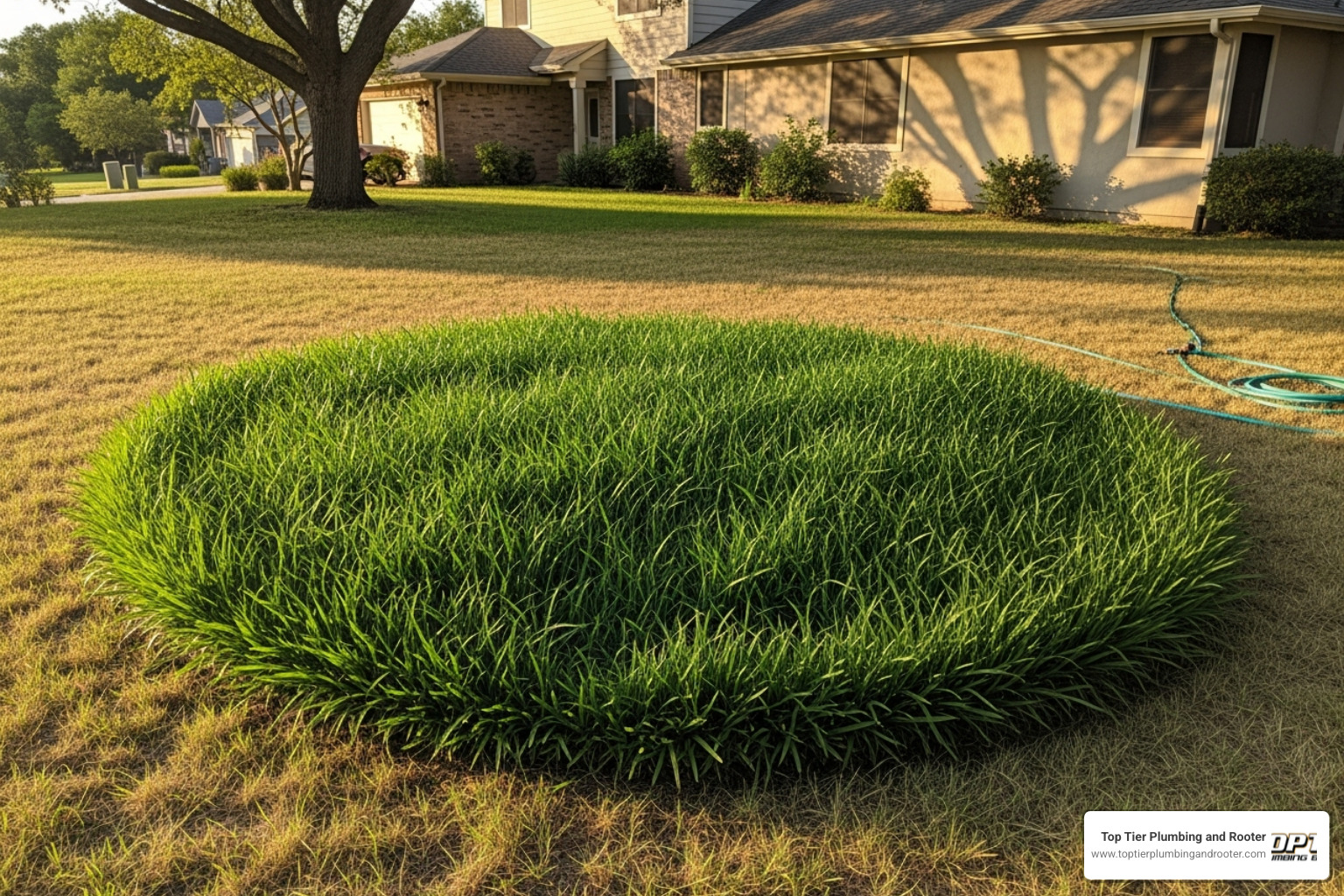
Soggy spots in the yard that appear without explanation can signal a leaking sewer line beneath. When wastewater escapes from damaged pipes, it saturates the soil above, creating persistently wet areas that never seem to dry out – even during dry spells.
Indentations in your lawn or pavers might seem like minor landscaping issues, but they can indicate serious underground problems. When sewer leaks wash away soil over time, the ground above literally sinks, creating depressions in your yard or even under walkways and driveways.
An unexplained pest increase around your property isn’t just annoying – it’s informative. Rodents, flies, and cockroaches are drawn to the moisture and organic matter from sewer leaks. If you’re suddenly dealing with more unwanted visitors than usual, your sewer line might be sending them an invitation.
Cracks in your foundation or walls represent the most serious outdoor warning sign. While not always directly caused by sewer problems, persistent underground leaks can destabilize the soil around your home’s foundation. This shifting can lead to structural cracks that threaten your home’s integrity.
These outdoor clues often develop gradually, making them easy to dismiss as normal wear and tear. But when you notice them alongside any indoor symptoms, it’s time to take action. For urgent situations, our comprehensive guide on Sewer Clearing Emergency: How to Identify and Address Urgent Sewage Issues provides essential information for protecting your home and family.
Common Causes of Severe Sewer Line Damage
Understanding why your sewer line might be failing helps you prevent future headaches and choose the best residential sewer replacement approach. Think of it like knowing why your car broke down – it helps you avoid the same problem next time and pick the right fix.
Both Mother Nature and human habits can wreak havoc on your underground pipes, often working together to create the perfect storm of sewer line failure.
Natural and Environmental Factors
Nature doesn’t always play nice with your plumbing. Here in Riverside and San Bernardino counties, we see these natural culprits causing serious damage year after year.
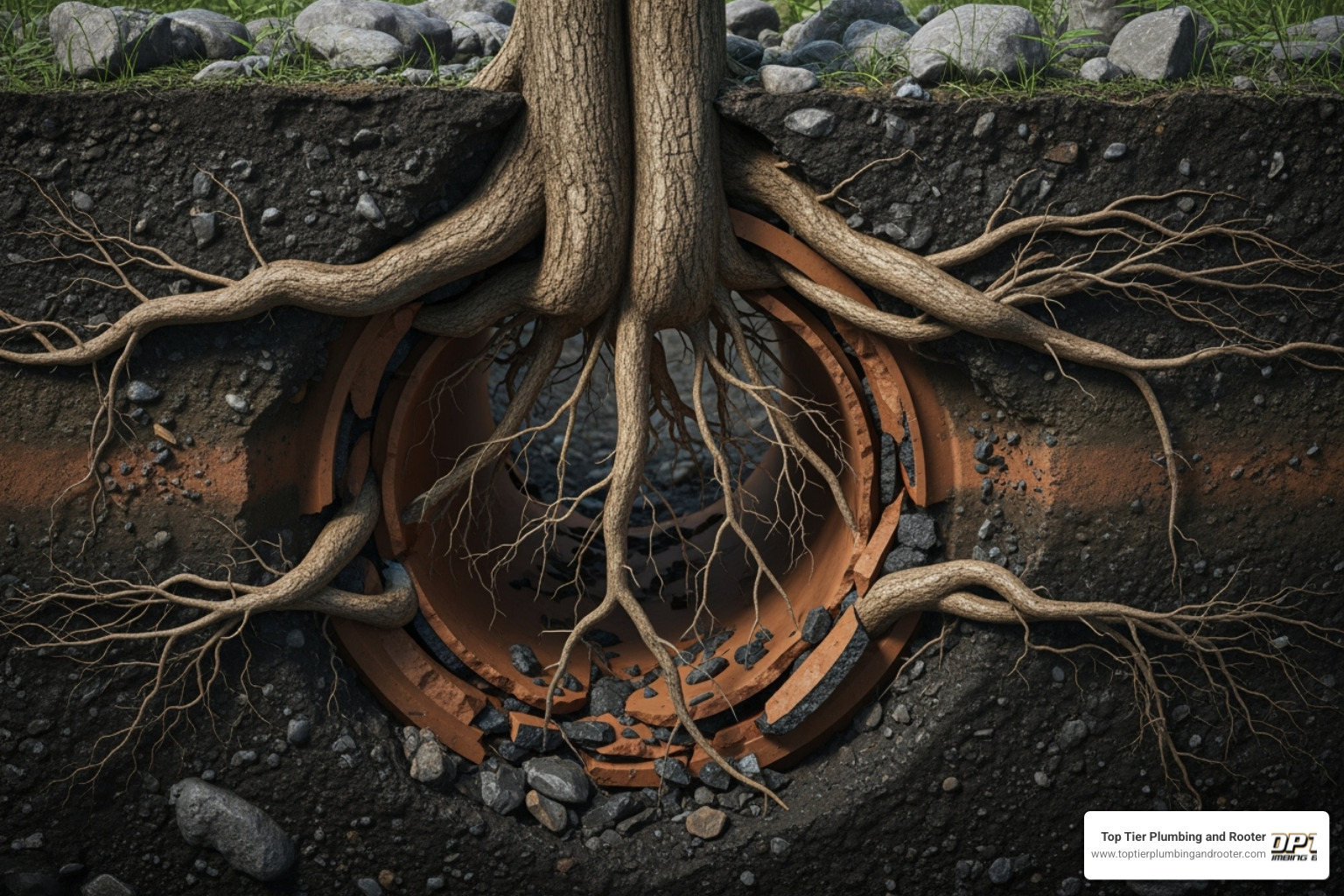
Tree root intrusion is the classic villain in most sewer line horror stories. Those beautiful trees in your yard? Their roots are constantly searching for water, and even the tiniest crack in your sewer pipe is like a neon “Open 24 Hours” sign to them. Once roots find their way in, they grow thick and strong, creating blockages that can eventually burst your pipes completely. This problem is especially common with older clay or cast iron pipes that have loose joints. We’ve written extensively about how Plumbing Under Siege: Defending Your Pipes from Invasive Roots in Riverside and San Bernardino County affects so many homeowners in our area.
Shifting soil might sound harmless, but it’s surprisingly destructive. The ground under your home is constantly moving due to erosion, earthquakes (a real concern in Southern California), and heavy rains. When soil shifts, your pipes shift with it, leading to cracks, disconnected joints, or complete collapse.
Extreme temperature changes put incredible stress on underground pipes. When the ground freezes and thaws repeatedly, it expands and contracts like a giant accordion, squeezing your pipes until they crack. Even in our relatively mild climate, temperature swings can cause problems over time.
Pipe material aging is simply the march of time catching up with your plumbing. Every material has its expiration date. Clay pipes from the early 1900s to 1950s, concrete pipes from the 1950s-1970s, and cast iron pipes installed before 1960 are all living on borrowed time. These materials corrode, crack, and become increasingly fragile with age. The good news? Modern PVC pipes can last 100 years or more, making residential sewer replacement a long-term investment.
Man-Made Issues
Sometimes we’re our own worst enemies when it comes to sewer line health. Human habits and mistakes cause plenty of problems that could easily be avoided.
Pipe corrosion happens when time and chemistry team up against your plumbing. Cast iron pipes are especially vulnerable to internal rust that eats away at the pipe walls until they’re paper-thin. Hard water with high mineral content speeds up this process, creating buildup that further weakens the pipes.
Clogs from grease or foreign objects might seem minor, but they create serious pressure inside your pipes. When you pour grease down the drain or flush those “flushable” wipes (spoiler alert: they’re really not flushable), you’re setting up your system for failure. These blockages don’t just stop water flow – they can actually crack pipes from the inside out. Our Ultimate Main Sewer Clog Guide explains exactly how these seemingly innocent mistakes can lead to major problems.
Improper pipe installation is a problem that keeps giving. When sewer lines aren’t installed with the correct slope, have poor connections, or lack proper support, they develop issues like “bellies” – sagging sections that collect debris and wastewater. These installation mistakes often don’t show up for years, but when they do, they usually require complete replacement.
Damage from construction can happen in a split second but cause years of problems. Whether it’s a landscaping project, home addition, or utility work, heavy equipment can easily crush or crack your sewer line. Even something as simple as driving a loaded truck over your line can cause damage if the pipe isn’t properly protected.
The key is recognizing that sewer line damage rarely has just one cause. Often, it’s a combination of factors – maybe tree roots found their way into an aging pipe that was improperly installed decades ago. Understanding these causes helps you make informed decisions about repair versus replacement and how to protect your investment going forward.
Repair vs. Replacement: Making the Right Choice
When your sewer line starts acting up, you’re faced with a crucial decision: should you patch things up with a repair, or bite the bullet and go for a full residential sewer replacement? It’s like deciding whether to keep fixing that old car or finally trade it in for something reliable.
The truth is, there’s no one-size-fits-all answer. Every situation is unique, and what works for your neighbor might not be the best solution for your home. That’s where professional expertise comes in handy.
When a Sewer Line Repair is Sufficient
Sometimes, your sewer line just needs a little TLC rather than major surgery. Think of it like patching a small hole in your favorite jeans instead of throwing them away.
Isolated cracks or holes are often perfect candidates for spot repairs. If a camera inspection shows just one small problem area in an otherwise healthy pipe, targeted repair methods like pipe lining can seal things up nicely. It’s efficient and gets the job done without unnecessary disruption.
Minor root intrusion is another situation where repairs often make sense. When tree roots have just started their unwelcome invasion but haven’t caused major structural damage, we can clear them out and line that section to prevent future problems. It’s like stopping a small leak before it becomes a flood.
Leaking joints between pipe sections are common in older systems, but they don’t always spell doom for the entire line. If the pipes themselves are still in good shape, we can often reseal or line these problem joints to restore proper function.
Spot repairs work well when damage is truly localized. We can excavate just the problem area and replace that specific section, leaving the rest of your system intact. While this still involves some digging, it’s far less invasive than replacing your entire line. For more details on these targeted solutions, check out our Drain Cleaning/Sewer Drain Repair services.
When a Full Replacement is Necessary
Here’s where we need to have an honest conversation. Sometimes, trying to repair an old, failing sewer line is like putting a band-aid on a broken bone – it might help temporarily, but it won’t solve the underlying problem.
Extensive damage throughout your sewer line makes repairs impractical. When you’re looking at multiple cracks, widespread corrosion, or significant root intrusion along most of the pipe, patching individual spots becomes a never-ending (and expensive) game of whack-a-mole.
Collapsed or bellied pipes leave you with no choice but replacement. A collapsed section simply can’t transport wastewater anymore – it’s game over. A “bellied” pipe, where a section has sagged and creates a low spot, will constantly collect debris and cause recurring backups no matter how many times you clear it.
Old pipe materials are often the deciding factor. If your home still has original clay pipes from the 1940s, cast iron from the 1950s, or that infamous Orangeburg “fiber pipe” from the 1960s, you’re living on borrowed time. Even if current damage seems minor, these materials are well past their prime and prone to sudden failures. Modern residential sewer replacement with PVC or HDPE pipes gives you decades of worry-free service.
Recurring problems are your sewer line’s way of waving a white flag. If you’re constantly dealing with backups, calling for drain clearing, or patching different sections, your system is telling you it’s ready for retirement. At this point, the ongoing headaches and cumulative repair expenses usually make replacement the smarter long-term investment.
The crucial first step in making this decision is getting a professional sewer camera inspection. This isn’t guesswork – we use specialized cameras to travel the entire length of your sewer line, documenting every crack, root intrusion, and problem area. This video evidence shows you exactly what’s happening underground, so you can make an informed decision based on facts, not fear.
We believe you have every right to see that inspection video – it’s your property, after all! Understanding more about this diagnostic process? Our guide on The Role of Video Inspection in Sewer and Drain Repair explains how this technology helps us recommend the most appropriate solution for your specific situation.
A Guide to Residential Sewer Replacement Methods
Once you’ve made the decision for residential sewer replacement, you’ll be choosing between two main approaches: traditional excavation and modern trenchless methods. Each has distinct advantages depending on your specific situation, and understanding both will help you make the best choice for your home.
![TABLE] comparing Traditional vs. Trenchless Sewer Replacement (Disruption, Time, Durability, Landscaping Impact). – residential sewer replacement infographic ](https://images.bannerbear.com/direct/4mGpW3zwpg0ZK0AxQw/requests/000/105/220/319/DdWb1LGkNYNMDNKGQ70OKvRAP/f30dcd7b030f801efd80eddbe48be8e242a816b9.jpg)
The choice between methods often comes down to your priorities: budget, timeline, and how much disruption you can handle. Your main sewer line is a critical lifeline for your home’s plumbing system, so choosing the right replacement method matters. For more detailed information about this essential component, visit our Main Sewer Line page.
Traditional Residential Sewer Replacement (Excavation)
When most people think about replacing underground pipes, they picture the traditional excavation method. It’s been around the longest and sometimes remains the best option for certain situations.
Trench digging is the hallmark of traditional replacement. Your crew will dig a continuous trench across your property to expose the entire damaged sewer line. This might mean cutting through your beautiful lawn, removing sections of your driveway, or even breaking up sidewalks – essentially creating a temporary construction zone in your yard.
Once the old pipe is fully exposed, full pipe removal begins. The damaged line is completely taken out and replaced with brand-new pipe sections, typically modern PVC that can last 100 years or more.
The pros of traditional excavation include complete control over the installation process. Your plumber can inspect every inch of the new pipe, ensure proper slopes for drainage, and address any underlying soil issues. When pipes are severely collapsed or when the sewer line’s route needs to be changed, excavation might be your only option.
However, the cons are significant and worth considering carefully. The process is highly destructive to your property, often requiring extensive landscape restoration afterward. It’s also time-consuming, with most projects taking anywhere from one to five days depending on the length and complexity of your sewer line. During this time, you’ll have limited or no sewer service, plus the inconvenience of construction activity around your home.
Modern Trenchless Residential Sewer Replacement
Trenchless technology has transformed residential sewer replacement, offering homeowners less disruptive alternatives that often work just as well as traditional methods. As we explore in The Benefits of Trenchless Sewer Repair: Why It’s a Game Changer for Homeowners, these innovative techniques have revolutionized how we approach sewer problems.
The beauty of trenchless methods lies in their minimal digging approach. Instead of excavating your entire yard, technicians typically need only one or two small access points at either end of your sewer line. This means your prize-winning roses, newly paved driveway, and carefully maintained lawn stay largely untouched.
Less disruption translates to real savings – not just in money, but in stress and time. You won’t need to replant your garden or repair your landscaping afterward. Most trenchless projects achieve faster completion times too, with many jobs finished within 24 hours compared to the several days required for traditional excavation.
The durability of trenchless solutions often matches or exceeds traditional methods. The new pipes or liners are typically seamless, resistant to root intrusion, and designed to last 50 years or more.
Pipe bursting works by pulling a new pipe through the old damaged one. A specially designed bursting head fractures the old pipe while simultaneously pulling the new HDPE (high-density polyethylene) pipe into place. The old pipe fragments get displaced into the surrounding soil, and you end up with a completely new pipe that maintains the original diameter.
Pipe lining takes a different approach by creating a “pipe within a pipe.” A flexible, resin-coated tube gets inserted into your existing damaged sewer line. Once in position, the tube is inflated and cured using heat or steam, forming a seamless new lining that seals cracks and prevents future root intrusion. While this method slightly reduces the pipe’s internal diameter by about a quarter inch, it creates a smooth surface that actually improves water flow and provides excellent durability for pipes with cracks, leaks, or minor root problems.
How to Prevent Future Sewer Line Problems
An ounce of prevention is worth a pound of cure, especially when it comes to your sewer line. Taking proactive steps can significantly reduce the likelihood of needing another residential sewer replacement down the road.
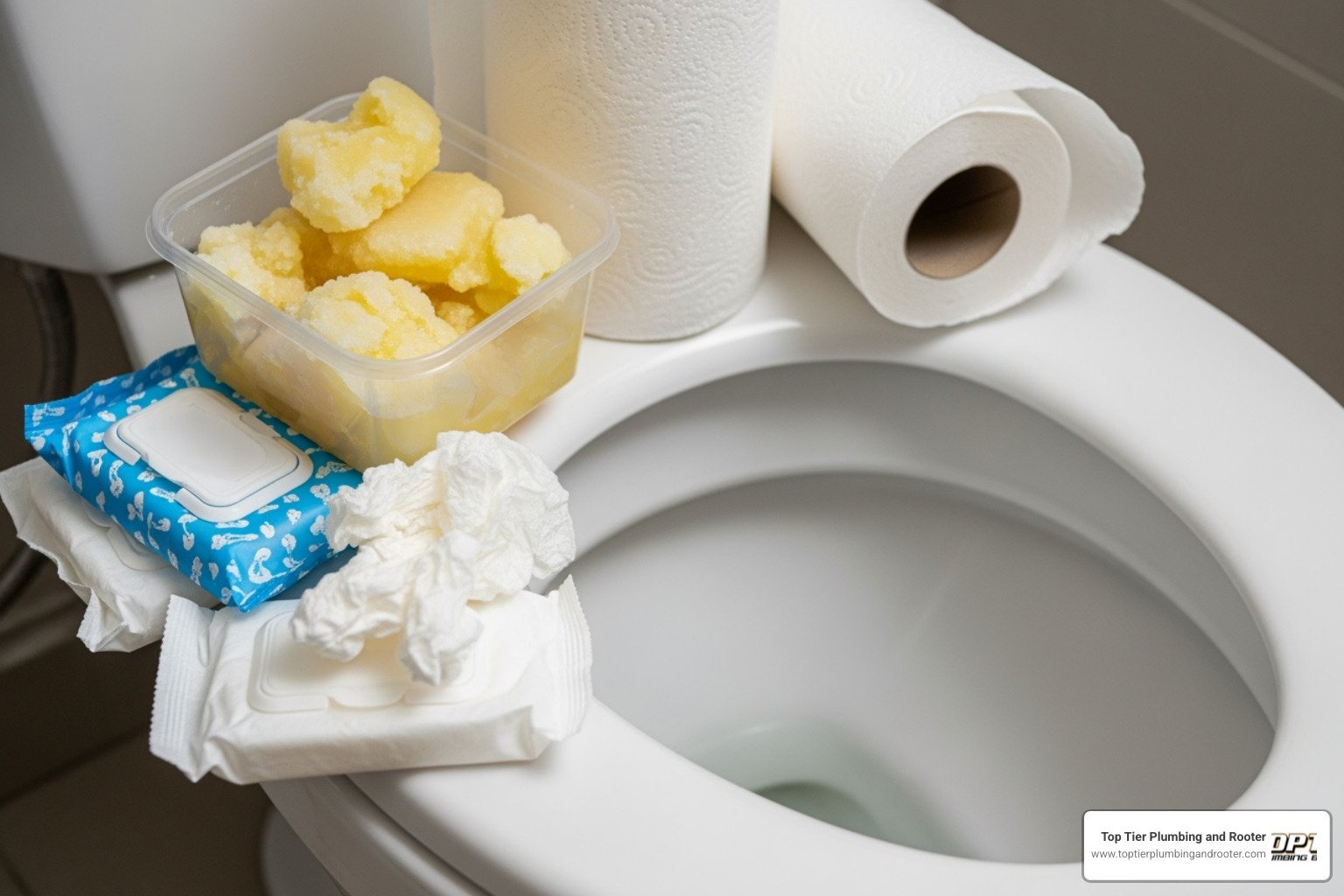
The good news is that most sewer line problems are preventable with the right habits and regular care. Think of your sewer line like any other major system in your home – it needs attention to keep working properly.
Proper drain usage is your first line of defense. What goes down your drains has a direct impact on your sewer line’s health. Never pour grease, oil, or food scraps down the drain – they solidify in pipes and create stubborn clogs that can put pressure on your entire system. Instead, let grease cool and scrape it into the trash.
When it comes to your toilet, remember it’s not a garbage can. Never flush non-biodegradable items like “flushable” wipes (they don’t break down like toilet paper promises), paper towels, feminine hygiene products, cotton balls, or dental floss. These items are major contributors to clogs and can cause serious backups.
Regular maintenance is like getting a physical checkup for your plumbing. We recommend scheduling professional drain cleaning to keep your lines clear and catch minor issues before they become major headaches. Our Drain Cleaning/Sewer Cleaning services help you stay ahead of problems rather than chasing them.
Scheduling professional inspections every few years can be a real game-changer, especially for older homes. A video camera inspection allows us to see the internal condition of your pipes, identify early signs of root intrusion, cracks, or corrosion, and address them before they lead to a complete failure. It’s much easier (and less expensive) to fix a small crack than to replace an entire collapsed line.
Root management strategies are crucial if you have large trees near your sewer line. Consider installing root barriers or choosing non-invasive tree species for future plantings. Regular professional root removal can help manage existing problems, but if roots are a persistent issue, a trenchless replacement that creates a seamless, root-proof pipe offers an excellent long-term solution.
The key is being proactive rather than reactive. Small investments in prevention and maintenance can save you from the stress and disruption of emergency repairs or full residential sewer replacement. Your sewer line works hard for you every day – a little care goes a long way in keeping it healthy.
Frequently Asked Questions about Sewer Line Replacement
When it comes to residential sewer replacement, we understand you have questions. After helping countless homeowners in Riverside and San Bernardino counties, we’ve heard just about every concern you might have. Let’s tackle the most common ones together.
How long does a new sewer line last?
Here’s some great news: a properly installed new sewer line is truly a long-term investment in your home. The lifespan depends heavily on the pipe material you choose and the quality of installation.
PVC pipes are the modern gold standard, and for good reason. These lightweight, durable pipes resist corrosion and can easily last 100 years or more with proper installation. They’re what we typically recommend for most residential sewer replacement projects because they simply perform better over time.
Cast iron pipes, while strong and still used in some applications, are more prone to internal corrosion. A new cast iron line might serve you well for 75-100 years, but honestly, PVC usually offers better value and longevity for residential applications.
When you go with professional installation, you’re setting yourself up for decades of reliable service. A new line can last 50-100+ years depending on the materials chosen. That’s potentially a once-in-a-lifetime improvement to your home’s infrastructure.
What is the difference between pipe bursting and pipe lining?
Both methods are fantastic trenchless solutions, but they work quite differently to solve your sewer problems.
Pipe bursting is like threading a needle with a sledgehammer – in the best possible way. This method fractures the old pipe while pulling a new one through in the same motion. A cone-shaped bursting head attached to a new HDPE pipe (high-density polyethylene) gets pulled through your damaged line. As it travels, it breaks apart the old pipe and pushes those fragments into the surrounding soil, while simultaneously laying the brand new pipe in exactly the same spot.
Pipe lining, on the other hand, creates a new pipe inside the old one. We insert a flexible tube coated with special epoxy resin into your existing sewer line. Once it’s positioned correctly, we inflate it and cure it in place using heat or steam. This CIPP (Cured-in-Place Pipe) process forms a seamless, durable new pipe within your old one.
The key difference? Pipe bursting gives you a completely new pipe at full diameter, while pipe lining rehabilitates your existing pipe by creating a smooth, sealed inner layer. Both methods avoid the massive excavation of traditional replacement, but the choice between them depends on your specific situation and pipe condition.
Does homeowners insurance cover sewer line replacement?
This question always makes homeowners nervous, and we totally understand why. The honest answer is that most typical policy exclusions mean standard homeowners insurance usually doesn’t cover residential sewer replacement.
Insurance companies generally consider sewer line problems “wear and tear” rather than sudden, unexpected damage. They view pipe aging, root intrusion, and general deterioration as maintenance issues that fall squarely on the homeowner’s shoulders. It’s frustrating, but that’s the reality most of us face.
However, there are exceptions. If your sewer line gets damaged by something covered under your policy – like a contractor accidentally hitting it during permitted work, or damage from a specific covered disaster – you might have coverage. The key distinction is “wear and tear” vs. sudden damage.
Many homeowners are finding optional add-ons specifically designed for utility lines. These service line coverage endorsements can provide protection for water, sewer, and electrical lines running from your home to the street connection. Home warranty coverage might also offer some protection, though the terms vary widely between providers.
Our advice? Review your policy carefully and consider speaking with your insurance agent about utility line coverage options. It’s one of those things you hope you’ll never need, but you’ll be grateful to have if problems arise.
Your Next Steps for a Healthy Sewer System
Dealing with residential sewer replacement doesn’t have to feel like navigating a maze blindfolded. We’ve walked through the warning signs your sewer line might be crying for help, explored what causes these underground pipes to fail, and discussed when a repair might do the trick versus when it’s time for a complete replacement. We’ve also covered the modern methods available to restore your home’s plumbing system without turning your yard into a construction zone.
The biggest lesson here? Don’t go it alone. Sewer line problems are like icebergs – what you see on the surface is often just a fraction of what’s happening below. These issues require specialized equipment, years of expertise, and knowledge of local regulations that most homeowners simply don’t have. Attempting to tackle sewer line problems yourself can turn a manageable situation into a costly disaster, not to mention the potential health risks involved.
When you’re ready to choose a professional for your sewer line needs, look for certain qualities that separate the pros from the pretenders. Licensed and insured plumbers aren’t just a nice-to-have – they’re essential for ensuring work meets industry standards and protecting you from liability. Upfront pricing means no unpleasant surprises when the bill arrives, and transparent communication ensures you understand exactly what’s wrong, how it’ll be fixed, and what to expect throughout the process.
Experience matters tremendously, especially with modern trenchless technologies that can save your landscaping and your sanity. A company that guarantees their work is telling you they’re confident enough in their expertise to stand behind it – that’s the kind of partner you want when dealing with something as critical as your home’s sewer system.
Here in Riverside and San Bernardino counties, we’ve seen it all – from century-old clay pipes finally giving up the ghost to newer lines damaged by our region’s shifting soils and aggressive tree roots. At Top Tier Plumbing and Rooter, we understand that plumbing emergencies don’t wait for convenient business hours, which is why we offer 24/7 availability and same-day service. Our commitment to upfront pricing, 100% satisfaction, and getting the job done right the first time means you can focus on getting back to your normal routine instead of worrying about your plumbing.
Your sewer line works hard every day, quietly carrying away waste and keeping your home healthy and comfortable. When it starts to fail, it deserves professional attention that addresses not just the immediate problem, but sets you up for decades of reliable service ahead.
Don’t let a failing sewer line hold your household hostage or threaten your property’s value. For expert diagnosis and modern solutions, explore our trenchless sewer repair services and find how we can restore your peace of mind with minimal disruption to your daily life.


